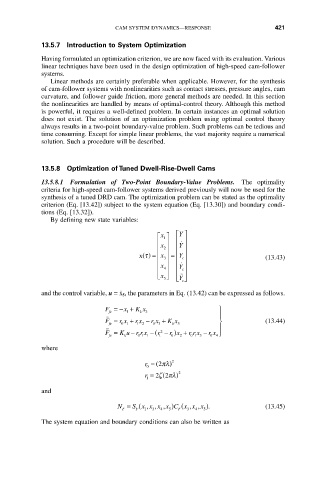Page 433 - Cam Design Handbook
P. 433
THB13 9/19/03 7:56 PM Page 421
CAM SYSTEM DYNAMICS—RESPONSE 421
13.5.7 Introduction to System Optimization
Having formulated an optimization criterion, we are now faced with its evaluation. Various
linear techniques have been used in the design optimization of high-speed cam-follower
systems.
Linear methods are certainly preferable when applicable. However, for the synthesis
of cam-follower systems with nonlinearities such as contact stresses, pressure angles, cam
curvature, and follower guide friction, more general methods are needed. In this section
the nonlinearities are handled by means of optimal-control theory. Although this method
is powerful, it requires a well-defined problem. In certain instances an optimal solution
does not exist. The solution of an optimization problem using optimal control theory
always results in a two-point boundary-value problem. Such problems can be tedious and
time consuming. Except for simple linear problems, the vast majority require a numerical
solution. Such a procedure will be described.
13.5.8 Optimization of Tuned Dwell-Rise-Dwell Cams
13.5.8.1 Formulation of Two-Point Boundary-Value Problems. The optimality
criteria for high-speed cam-follower systems derived previously will now be used for the
synthesis of a tuned DRD cam. The optimization problem can be stated as the optimality
criterion (Eq. [13.42]) subject to the system equation (Eq. [13.30]) and boundary condi-
tions (Eq. [13.32]).
By defining new state variables:
Y
x
È ˘ È ˘
1
Í ˙ Í ˙
˙
x
Y
Í ˙ Í ˙
2
Í ˙
x t () = Í ˙ = Y c (13.43)
x
3
Í ˙ Í ˙
x
Y
Í ˙ Í ˙ ˙ c
4
Í ˙ Í ˙
˙˙
x
Î ˚
Î Í ˚ ˙
Y
5
c
.
and the control variable, u = x 5 , the parameters in Eq. (13.42) can be expressed as follows.
F =- x + K x ¸
fe 1 k 3
Ô
˙˙
F = r x + r x - r x + K x ˝ (13.44)
fe 0 1 1 2 0 3 k 5
˙˙˙
r x +
-
F = K u r rx -( r - ) r rx - r x Ô
2
˛
fe k 011 1 0 2 0 1 3 0 4
where
r = ( 2pl ) 2
0
22 (
r = zpl ) 2
1
and
)
( ,, ,
( , ,
N = S x x xx C x xx ). (13.45)
F F 1 3 4 5 F 3 4 5
The system equation and boundary conditions can also be written as

